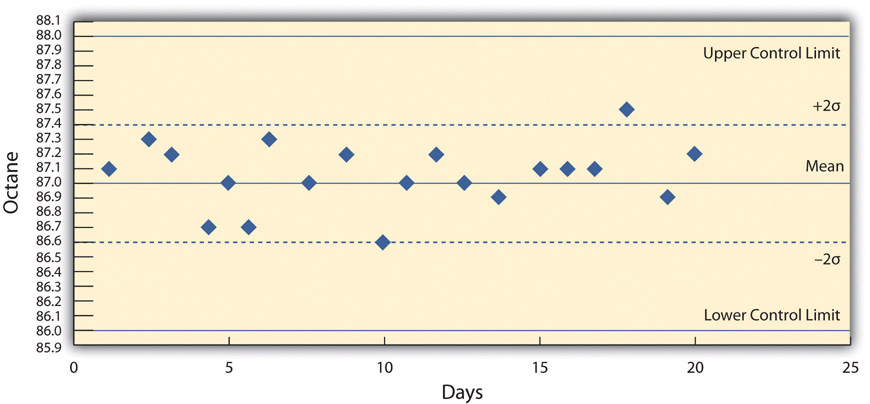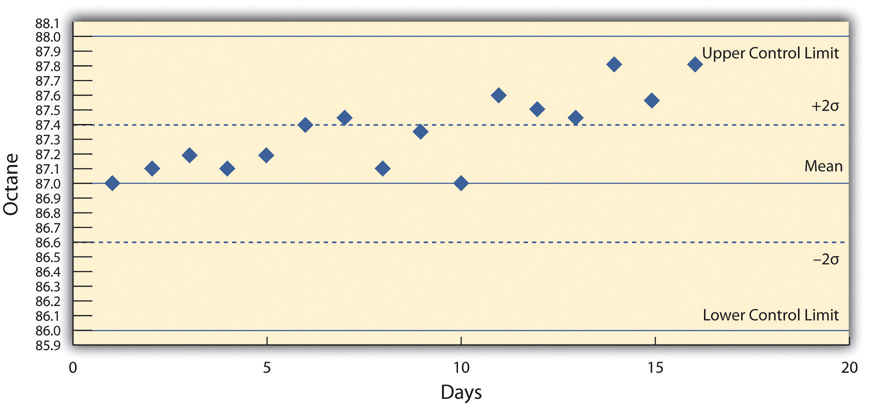Visit Audio Recordings for the audio version of this section.
LEARNING OBJECTIVES
- Describe the historical events and forces that led up to today’s emphasis on quality as a competitive requirement.
- Describe quality awards in Japan and the United States.
- Describe quality programs and standards such as TQM, Six Sigma, and ISO 9000.
- Describe and calculate the cost of quality.
Quality management is an approach to work that has become increasingly important in every field, including instructional design, as global cooperation and competition have increased. A review of the history of quality management explains why it is so important for you to understand and why clients often require documentation to show that your processes satisfy their quality standards.
HISTORY
Prior to the late 1700s, products such as firearms and clocks were made as unique, individual works. If a part broke, a new one had to be made by hand to fit. In 1790 in France, Honoré Blanc demonstrated that he could make musket parts so nearly identical that a musket could be assembled from bins of parts chosen at random.1 The practice of making parts to a high level of accuracy in their dimensions and finishes made the parts interchangeable. The use of interchangeable parts became the founding principle of assembly-line manufacturing to produce all manner of goods from sewing machines to automobiles to computer chips. The manufacturers of firearms and weapons were often the leaders in improving quality because reliable and safe operation of weapons and their rapid repair is a matter of life and death.
Statistical Control in the United States During World War II
During World War II, factories were converted from manufacturing consumer goods to weapons. War plants had to make large numbers of parts as fast as possible while doing it safely for the workers and for the service members who used them. Important improvements in quality control (QC)—the management of production standards through statistical interpretation of random product measurements, which emphasizes consistency and accuracy—were made during this period.
A key figure in the history of quality management who was an important person in the war effort was Walter Shewhart at Bell Telephone Laboratories. Shewhart recognized that real processes seldom behaved like theoretical random distributions and tended to change with time. He separated causes of variation into two categories: chance cause and assignable cause. Chance causes could be ignored if they did not cause too much variation, and trying to eliminate them often made the problem worse, but assignable causes could be fixed. To help distinguish between variations caused by random events and trends that indicated assignable causes, Shewhart introduced the control chart, which is also known as a type of run chart because data are collected while the process is running. A control chart has time on the bottom axis and a plot of sample measurements. The mean, upper control limit, lower control limit, and warning lines that are two sigma from the mean are indicated by horizontal lines.
Control Chart Shows Production Variation of Gasoline
The refinery quality control manager takes samples each day of the 87 octane gasoline for twenty days and charts the data on a control chart, as shown below.
Figure 10.6 Control Chart Displaying Variations Due to Chance Causes

She recognizes that the highest and lowest measurements are not part of a trend and are probably due to chance causes. However, the control chart from the next twenty days, as shown below, indicates an upward trend that might be due to an assignable cause. She alerts the process manager to let him know that there is a problem that needs to be fixed before the product exceeds the upper control limit. This might indicate the need to initiate a project to fix the problem.
Figure 10.7 Control Chart Displaying Variations That Might Be Due to an Assignable Cause

Deming and Postwar Japan
The most influential person in modern quality control was an American who was a hero in Japan but virtually unknown in the United States. W. Edwards Deming worked with Shewhart at Bell Labs and helped apply Shewhart’s ideas to American manufacturing processes during World War II. Following the war, American factories returned to the production of consumer goods. Many of the other major manufacturing centers in the world had been damaged by bombing during the war and took time to recover. Without the safety needs of wartime and with little competition, quality control was not a high priority for American companies.2 Management in the United States focused on increasing production to meet demand and lowering costs to increase profits.
After the war, while the United States occupied Japan, Deming was asked by the U.S. Department of the Army to assist with the statistics of the 1950 census in Japan. Kenichi Koyanagi, the managing director of the Union of Japanese Scientists and Engineers and a very influential industrialist, asked Deming to speak to twenty-one top industrial leaders on the topic of global strategy for Japanese industry. Deming went beyond Shewhart’s work and talked about his philosophy of quality manufacturing and how the responsibility for quality begins with management. He explained that a corporate culture devoted to producing high-quality products would result in less waste, lower costs, greater client loyalty, and greater market share. With Koyanagi’s support, Deming’s ideas were widely adopted by these influential leaders.
Deming described his philosophy as a system of profound knowledge, which has four parts:
- Appreciation of a system. Understanding how suppliers, producers, and clients interact.
- Knowledge of variation. Understanding statistical variation.
- Theory of knowledge. Understanding what can be known and what cannot.
- Knowledge of psychology. Understanding human nature.
In 1950, the Japanese created the Deming prize in Deming’s honor, which is awarded to an individual and a company for major advances in quality improvements. In 1960, Deming was awarded the Order of the Sacred Treasure, Second Class by the Prime Minister on behalf of Emperor Hirohito.

Quality Management in America
By the 1970s, Japanese companies had a reputation for high quality and were taking market share from American companies, but Deming’s teachings were virtually unknown in his own country. It was not until 1980 that America became aware of Deming when his work was described in an NBC documentary titled If Japan Can, Why Can’t We?3 By then, Deming was eighty years old and the producer of the show originally assumed he was dead.4
In 1982, Deming’s book was published and later retitled Out of Crisis, in 1986.5 It was aimed at explaining his system to American manufacturers and the American public. In the book, Deming described fourteen principles of management to guide the implementation of his philosophy. Some of them were challenges to Western managers and very different from the thinking that was prevalent at the time. In brief, they are as follows:
- Create constancy of purpose toward improvement of product and service.
- Adopt a new philosophy. We are in a new economic age. Western management must awaken to the challenge, learn their responsibilities, and take on leadership for a change.
- Cease dependence on inspection to achieve quality. Eliminate the need for inspection on a mass basis by building quality into the product in the first place.
- End the practice of awarding business on the basis of price tag. Instead, minimize cost. Move toward a single supplier for any one item, on a long-term relationship of loyalty and trust.
- Improve constantly and forever the system of production and service to improve quality and productivity and thus constantly decrease costs.
- Institute training on the job.
- Institute leadership. The aim of supervision should be to help people and machines and gadgets to do a better job. Supervision of management is in need of overhaul, as well as supervision of production workers.
- Drive out fear, so that everyone may work effectively for the company.
- Break down barriers between departments.
- Eliminate slogans, exhortations, and targets for the workforce asking for zero defects and new levels of productivity.
- Eliminate work standards (quotas) on the factory floor. Substitute leadership.
- Remove barriers that rob the hourly worker of his right to pride of workmanship.
- Institute a vigorous program of education and self-improvement.
- Put everybody in the company to work to accomplish the transformation. The transformation is everybody’s job.
Between 1979 and 1982, Ford Motor Company lost $3 billion, and they were looking for solutions to their problems. They chose to apply Deming’s approach to develop the new Taurus-Sable model and by 1986 had become the most profitable American auto company.6
Ford adopted a Japanese approach to quality known in America as total quality management (TQM). TQM in Japan has four major components:
- Kaizen. Improvement must involve all members of a company.7
- Atarimae hinshitsu. Make things work the way they are supposed to work.8
- Kansei. Learn from the way a user applies the product to make improvements.9
- Miryokuteki hinshitsu. Things should have an aesthetic quality and be pleasing to use.10
According to Peter B. Petersen,11 TQM differs from the Deming approach in four fundamental ways:
- The Deming approach represents one philosophy that is used in its entirety or not at all. In contrast, TQM can be tailored to a particular environment.
- Both agree that a long-term commitment is required by top management. However, Deming would drop clients if they started to wane, while TQM consultants were less demanding.
- Deming insists on constancy of purpose, while TQM adapts to the situation, which results in lack of constancy.
- Deming requires adoption of his principles of profound knowledge, while TQM lacks this unified philosophy.
Many poorly qualified consulting firms provided training in TQM to American companies. The approach worked in some cases but not in others where it was applied superficially, and the movement’s credibility was diminished.
Another approach to quality management in the United States was formulated at Motorola in 1986 and was named Six Sigma (6σ). The Six Sigma practices were based on Deming’s work, TQM, and others and had similarities regarding continuous efforts at improvement involving everyone at the company. It emphasized a clear focus on achieving quantifiable financial returns from any Six Sigma project. To determine the financial return on a quality initiative, the cost of quality (COQ) must be determined. The cost of quality has two parts: the cost of prevention and the cost of failure (or nonconformance). The cost of quality is the difference between the additional money spent on prevention and the corresponding reduction in the cost of failure.
Cost of prevention
- Cost of conformance. Cost to improve quality
- Cost of appraisal. Cost to measure and evaluate quality
Cost of failure
- Internal costs. Repairing bad parts before shipment or retooling a manufacturing line to reduce failures
- External costs. Managing returns, lawsuits, product recalls
The name Six Sigma refers to a process that has six standard deviations from the mean to either control limit that would ensure virtually zero defects. This approach was adopted by Jack Welch at General Electric with great success. By the late 1990s, about two-thirds of the top five hundred companies in the United States had begun Six Sigma projects, including Ford, which had allowed its quality programs to slip. To provide encouragement and a consistent standard, the U.S. government created the Malcolm Baldrige National Quality Award in 1987 to encourage companies to improve quality; the award was named for Malcolm Baldrige who was the U.S. secretary of commerce from 1981 to 1987.12 The criteria used to determine award winners are as follows:
- Leadership of senior executives
- Strategic planning
- Customer and market focus
- Measurement, analysis, and knowledge management
- Workforce focus
- Process management
- Results
Often, instructional designers will be working with others who focus on quality within their organizations. Quality is usually associated with the evaluation portion of instructional design. It is important to understand the current quality management models that are employed so that evaluation of a design can be in line with organizational expectations.
Trade and International Standards
Trade between countries increased as countries recovered from WWII and began producing consumer goods. In 1948, the General Agreement on Tariffs and Trade (GATT) established the rules for international trade in the postwar world. Through years of negotiations based on GATT, the World Trade Organization (WTO) was created in 1995. The WTO is a negotiating forum where governments can discuss ways to help trade flow as freely as possible.13
Increases in trade forced companies to improve the quality of their products to compete for clients and to exchange parts reliably between companies that used parts suppliers. To assist in developing standards for quality that would be the same between countries, an organization of 158 national standards groups formed the International Organization for Standardization (ISO), which is headquartered in Switzerland. There are thousands of ISO standards, and they are grouped by their numbers. The ISO 9000 group of standards relate to quality.
Recommended steps for implementing a quality management system (QMS) are as follows:
- Fully engage top management.
- Identify key processes and the interactions needed to meet quality objectives.
- Implement and manage the QMS and its processes.
- Build your ISO 9001-based QMS.
- Implement the system, train company staff, and verify effective operation of your processes.
- Manage your QMS—focus on client satisfaction, strive for continual improvement.
- If necessary, seek third-party certification and registration of the QMS, or alternatively, issue a self-declaration of conformity.14
KEY TAKEAWAYS
- The need for production of safe, reliable weapons that could be mass produced led to use of methods to assure that parts were manufactured within controlled limits. An early example is the interchangeable musket parts produced in France in 1790 and, later, the quality control methods introduced by Shewhart in the United States during World War II.
- Following World War II, Japanese companies followed advice from Deming and others to make quality a top priority for management. Higher-quality products gave Japan a competitive advantage with U.S. consumers that forced U.S. firms to respond with similar quality programs.
- The Deming award is given by Japan to companies doing business in Japan for high-quality standards. Similarly, the Baldrige National Quality Award is given to U.S. companies and individuals for their contribution to quality.
- Total quality management is a flexible program that is adapted from Japanese practices that emphasize kaizen, participation by all; atarimaie hinshitsu, making things work the way they should; kansei, learning from the way the client uses the product to make improvements; and miryokuteki hinshitsu, giving products an aesthetic quality to make them pleasing to use. Six Sigma identifies specialists within the organization and assigns titles like Master Black Belt. Each quality project must evaluate the cost of quality to gain approval.
- The International Standards Institute devises guidelines for establishing practices. The ISO 9000 group are guidelines for establishing practices that are likely to create quality products.
- The cost of quality has two parts: the cost of prevention and the cost of failure. The cost of prevention includes costs to establish quality practices and the costs to verify them. The cost of failure includes internal costs before the product is sold, such as waste and fixing products, while external costs include those that occur after the product is sold, such as returns and lawsuits.
[1] Ken Alder, “Innovation and Amnesia: Engineering Rationality and the Fate of Interchangeable Parts Manufacturing in France,” Technology and Culture 38, no 2 (April 1997): 273–311.
[2] John Dowd, “How the Japanese Learned to Compete,” Asia Times, October 27, 2006,http://www.atimes.com/atimes/Japan/HJ27Dh01.html (accessed August 11, 2009).
[3] John Dowd, “How the Japanese Learned to Compete,” Asia Times, October 27, 2006,http://www.atimes.com/atimes/Japan/HJ27Dh01.html (accessed August 11, 2009).
[4] Thomas J. Boardman, “The Statistician Who Changed the World: W. Edwards Deming, 1900–1993,” The American Statistician 48 (August 1994): 179–87.
[5] W. Edwards Deming, Out of the Crisis (Boston: MIT Press, 1982).
[6] Andrea Gabor, “Ford Embraces Six-Sigma Quality Goals,” June 13, 2001, http://andreagabor.com/selected-articles/management-quality-revival-part-2-ford-embraces-six-sigma/ (accessed December 4, 2012).
[7] Encyclopedia Britannica, s.v. “Total Quality Control,”http://www.britannica.com/EBchecked/topic/1387304/Total-Quality-Control (accessed August 13, 2009).
[8] NationMaster.com, “Miryokuteki Hinshitsu,” 2005,http://www.statemaster.com/encyclopedia/Miryokuteki-Hinshitsu (accessed August 14, 2009).
[9] WASEDA University, “Kansei Quality,”http://www.tqm.mgmt.waseda.ac.jp/study/kansei_e.html (accessed June 20, 2010).
[10] NationMaster.com, “Miryokuteki Hinshitsu,” 2005,http://www.statemaster.com/encyclopedia/Miryokuteki-Hinshitsu (accessed August 14, 2009).
[11] Peter B. Petersen, “Total Quality Management and the Deming Approach to Quality Management,” Journal of Management History 5, no. 8 (1999): 468–88.
[12] National Institute of Standards and Technology, “Frequently Asked Questions about the Malcolm Baldrige National Quality Award,” November 25, 2008,http://www.nist.gov/public_affairs/factsheet/baldfaqs.cfm (accessed August 14, 2009).
[13] World Trade Organization, “Understanding the WTO: Basics,”http://www.wto.org/english/thewto_e/whatis_e/tif_e/fact1_e.htm (accessed August 14, 2009).
[14] International Organization for Standardization, Quality Management Systems—Fundamentals and Vocabulary (Geneva: ISO Press, 2005), in Project Management Institute, Inc., A Guide to the Project Management Body of Knowledge (PMBOK Guide), 4th ed. (Newtown Square, PA: Project Management Institute, Inc., 2008).
